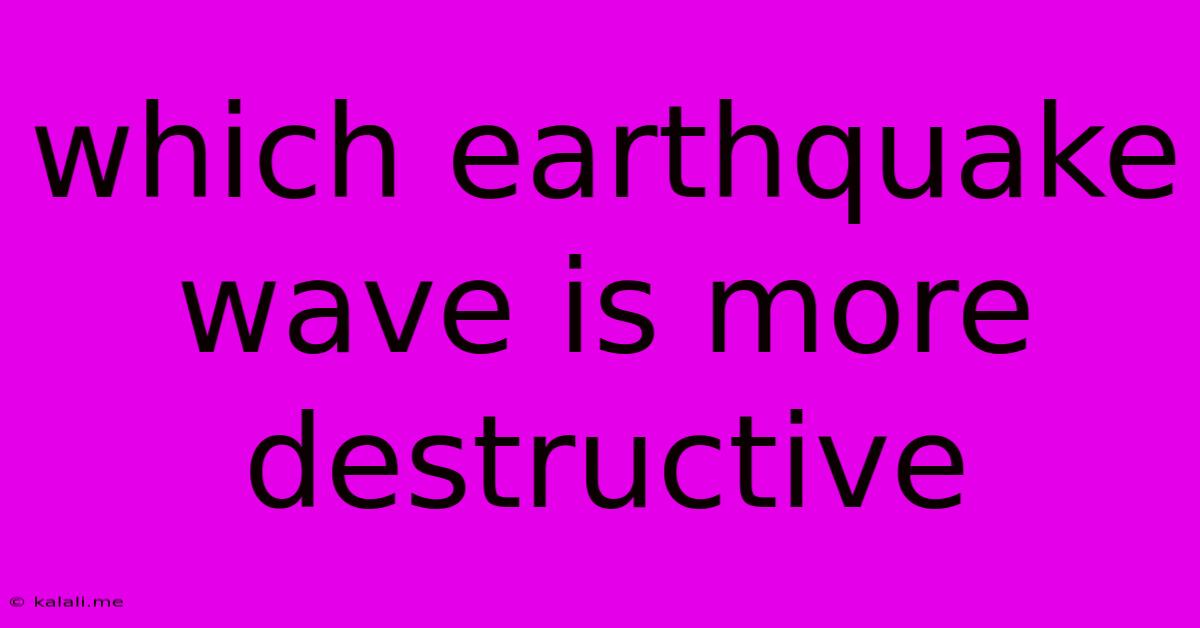Which Earthquake Wave Is More Destructive
Kalali
Jun 13, 2025 · 3 min read

Table of Contents
Which Earthquake Wave is More Destructive? Understanding Seismic Waves and Their Impact
Earthquakes, terrifying natural disasters, unleash a cascade of seismic waves that wreak havoc across landscapes. But which type of earthquake wave is truly the most destructive? Understanding the different types of waves and their characteristics is crucial to comprehending the devastation they cause. This article explores the destructive power of seismic waves, focusing on the key differences between P-waves, S-waves, and surface waves.
Understanding Seismic Waves: P-Waves, S-Waves, and Surface Waves
Earthquakes generate three main types of seismic waves:
-
P-waves (Primary waves): These are the fastest waves, traveling through both solid and liquid materials. They're compressional waves, meaning they cause particles to move back and forth in the same direction as the wave travels. Think of it like a slinky being pushed and pulled. While they're fast, their relatively low amplitude often means they cause less damage than other wave types.
-
S-waves (Secondary waves): Slower than P-waves, these waves only travel through solid materials. They're shear waves, causing particles to move perpendicular to the wave's direction – imagine shaking a rope up and down. Their greater amplitude compared to P-waves makes them more destructive.
-
Surface waves: These waves travel along the Earth's surface, and are the slowest but most destructive seismic waves. There are two main types:
- Love waves: These waves cause horizontal ground motion, similar to the shaking of a snake. Their shearing motion is extremely damaging to structures.
- Rayleigh waves: These waves cause rolling ground motion, similar to ocean waves. Their large amplitude and slow speed result in significant ground displacement, leading to substantial damage.
The Destructive Power: Why Surface Waves Reign Supreme
While S-waves possess greater amplitude than P-waves, it's the surface waves – particularly Love and Rayleigh waves – that are responsible for the majority of earthquake damage. This is due to several factors:
-
Higher Amplitude: Surface waves have significantly larger amplitudes than P and S waves, meaning they cause greater ground displacement. This intense shaking is what causes buildings to collapse and infrastructure to fail. The rolling motion of Rayleigh waves can also topple structures more easily than the horizontal shaking of Love waves.
-
Slower Speed: The slower speed of surface waves means that their energy is released over a longer period, increasing their destructive potential. The prolonged shaking allows buildings and other structures to experience more significant stress and strain, leading to greater damage.
-
Surface Focus: The energy of surface waves is concentrated near the Earth's surface, directly impacting structures and infrastructure. This direct impact maximizes the destructive effects.
Factors Influencing Damage:
The extent of earthquake damage is also influenced by various factors beyond the type of seismic wave, including:
- Magnitude of the earthquake: Larger magnitude earthquakes release more energy, resulting in more intense ground shaking.
- Distance from the epicenter: The closer a location is to the earthquake's epicenter, the greater the intensity of shaking.
- Soil conditions: Loose, unconsolidated soils amplify seismic waves, leading to greater damage compared to stable bedrock.
- Building construction: The design and construction of buildings play a significant role in determining their resistance to earthquake shaking.
Conclusion:
While all seismic waves contribute to the devastation caused by earthquakes, surface waves, particularly Love and Rayleigh waves, are generally considered the most destructive due to their high amplitude, slow speed, and surface concentration of energy. Understanding the characteristics of these waves is critical for developing effective earthquake-resistant building codes and disaster preparedness strategies. Further research into seismic wave propagation and ground motion continues to improve our understanding and mitigation efforts.
Latest Posts
Latest Posts
-
Which Of The Following Is An Example Of Symbiosis
Jun 14, 2025
-
Select The Word That Means Present From Birth
Jun 14, 2025
-
Which Of The Following Statements Is Not True About Friction
Jun 14, 2025
-
Middle Tennessee State University Act Requirements
Jun 14, 2025
-
How Long Is The Penalty Spot From The Goal
Jun 14, 2025
Related Post
Thank you for visiting our website which covers about Which Earthquake Wave Is More Destructive . We hope the information provided has been useful to you. Feel free to contact us if you have any questions or need further assistance. See you next time and don't miss to bookmark.